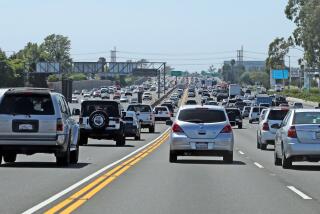Truckers group joins the drive to mandate speed-limiting devices
WASHINGTON — Stephen Owings, whose 22-year-old son died when his car was rear-ended, is fighting to have the federal government require the use of speed-limiting devices on all big rigs, saying: “We’re not against truckers; we’re pro-highway safety.”
Most often, citizen-crusaders find themselves in lonely, unequal struggles against industry groups and lobbyists. But this time, David and Goliath seem to be on the same side.
Owings has drawn support from the American Trucking Assns., or ATA, in his effort to get the U.S. Department of Transportation to require the use of the speed-inhibiting devices on big trucks -- or get Congress to mandate them in a highway bill soon to be drafted.
On the other side are conservatives who oppose government regulation of business as a matter of principle, truckers who own their own big rigs, and owners of smaller fleets represented by the Owner-Operator Independent Drivers Assn.
These include drivers such as Julia Scott, who said that from the cab of her 18-wheeler she sees passenger cars doing a lot more dangerous things than big trucks. If the government is going to require governors on trucks, she said, “they need to put speed-limiting devices in the cars.”
Both proponents and opponents of such regulation defend their positions in terms of public safety.
“One of the things that the trucking industry will say is, ‘Cars need to stay out of the trucks’ no-zone’ -- in other words, give them space,” Owings said. “Well, you can’t give them space if you’re driving along at the speed limit or even faster and some truck comes bearing down on you from behind going 85 mph.”
The ATA says the speed-limiting devices, already installed by many trucking lines voluntarily, will save lives and fuel.
“When the industry itself is asking for this requirement, it’s hard to see Congress finding fault with it,” ATA Senior Vice President Tim Lynch said.
The Owner-Operator Independent Drivers Assn., however, says mandatory speed governors are likely to lead to more collisions (when a driver needs extra horsepower for an emergency maneuver) and increase traffic congestion (when a speed-limited truck attempts to pass another).
Truck safety has generated interest on Capitol Hill in part because crashes involving big trucks tend to be serious and attract public attention.
Speeding -- whether a truck was traveling too fast for conditions or exceeding the speed limit -- was a factor in about 9% of fatal crashes involving large trucks in 2007, according to federal traffic safety officials.
In Southern California, speed was cited in two crashes on Interstate 5 that produced multiple fatalities in 2007: one in which a big rig rear-ended a minivan in Mission Viejo, killing three children; and a fiery chain-reaction accident in a tunnel near Santa Clarita that killed a child and two adults and injured 23 other people.
Though speed more often is a factor in fatal crashes involving passenger vehicles, the Insurance Institute for Highway Safety supports mandating the use of speed-limiting devices in big trucks because of the damage big rigs can cause given their weight and the distance needed to stop.
“The potential consequences of a truck going at a high speed are far more serious,” said Anne McCartt, the institute’s senior vice president for research.
Questioning whether the devices would reduce deadly crashes, the Owner-Operator Independent Drivers Assn. notes that most of the truck drivers involved in speed-related crashes were driving too fast for conditions, not in excess of the speed limit.
The effort to force trucks to slow down comes as a number of states have been raising speed limits. Utah recently gave the go-ahead for a test period during which trucks could travel up to 80 mph along a stretch of Interstate 15. The current limit is 75 mph. And Ohio, beginning today, will allow trucks to go 65 mph, the same as cars on most interstates, rather than 55 mph.
Owings began his fight after his son, Cullum, was killed on a Virginia interstate in 2002.
Cullum and his brother were returning to college from the family home in Atlanta when their car, stuck in traffic, was hit from behind by a big rig traveling on cruise control that was going 7 mph over the speed limit. The trucker was charged with reckless driving.
In 2006, Owings petitioned the Transportation Department to require the use of speed-limiting devices but got nowhere with the regulatory-wary Bush administration. But after a recent meeting with an Obama administration official, Owings is encouraged. “This administration is much more open to regulation,” he said.
The idea has generated strong reaction, as evidenced by the thousands of comments -- many of them negative -- sent to the Department of Transportation:
“I can envision a highway full of ‘speed limited’ trucks all trying to pass one another and a jam behind them for miles and miles,” Oklahoma truck driver Michael Babella wrote.
“There may be problems with some drivers, but all of us shouldn’t have to pay the price,” said Johnny Payne, a North Carolina trucker who recommended better driver training.
Owings, a financial planner, said he has driven a truck “out my desire to understand the trucker’s point of view.”
“Our belief is that professional truck drivers should be trained more like airline pilots,” he said. “We are working toward that vision tirelessly, including a campaign to educate passenger car drivers on how to drive more safely around heavy commercial trucks.”
--
More to Read
Sign up for Essential California
The most important California stories and recommendations in your inbox every morning.
You may occasionally receive promotional content from the Los Angeles Times.











